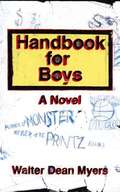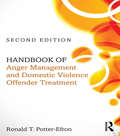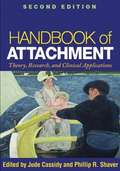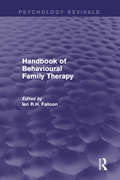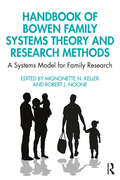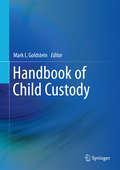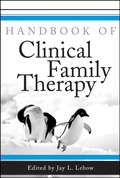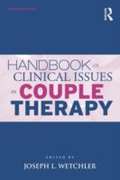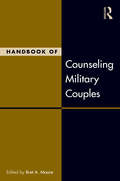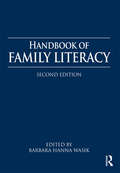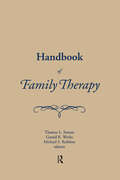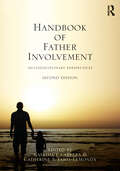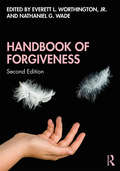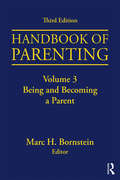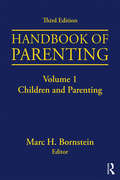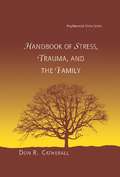- Table View
- List View
Handbook for Boys: A Novel
by Walter Dean MyersIn the groundbreaking tradition of his award-winning Monster and Bad Boy: A Memoir, Walter Dean Myers fashions a highly readable, powerful novel about the rules for success for young men, especially those navigating coming of age while Black.Jimmy and Kevin could use a guide to life. When each of the boys gets in the kind of trouble that almost lands them in juvenile detention, their neighbor Duke steps in and offers them jobs in his Harlem barbershop.The regulars at the barbershop seriously get on Jimmy’s nerves. Duke, Cap, and Mister M all seem determined to give the two boys a hard time. Still, it seems like everyone who walks through the door and sits in Duke’s chair has a story and a philosophy—whether they know it or not—and Jimmy is listening.It drives Jimmy nuts when the adults in his life assume he doesn’t know anything—and he’s got a lot of anger to go around. But it might turn out that listening to the conversations in Duke’s shop could be the education on living that Jimmy needs. In his introduction to Handbook for Boys, Walter Dean Myers wrote: "I know as a troubled teenager I would have loved to have a neighborhood barbershop to sit in and a group of worldly and knowledgeable men to counsel me. Thinking about this was my motivation in writing this book, hoping it will be, in the least, a jumping-off point for many interesting conversations about success."
Handbook for the Treatment of Abused and Neglected Children (Haworth Social Work Practice With Children And Families Ser.)
by P. Forrest TalleyPractical solutions for difficult clinical situations!With many chapters written by some of the field's best known contributors, this handbook was developed for the practitioner who wants practical and effective guidance for helping abused children. Each major area of clinical practice is discussed by experienced professionals, providing you with new insights and ideas regarding: medical findings; clinical assessment; individual, group, and family therapy; testifying in court; the role of medication in treatment, and much more. To make the application from the written page to your practice even more compelling, every clinical chapter is followed by a patient vignette that demonstrates how the principles just described can be successfully applied in the working world of therapists. Whether abused children number only a few or many on your caseload, this is a handbook to which you will often refer over the years. The Handbook for the Treatment of Abused and Neglected Children pulls together a wide range of practical information for therapists on how to effectively work with abused and neglected children. Unlike other volumes on the subject, this book puts the information in context, with a &’big picture&’ overview of how the therapist fits into the larger system into which the child has been swept up-Child Protective Services, legal proceedings, medical issues, disputes regarding custody, etc. Inside, you&’ll find effective strategies for: conducting individual therapy with abused children-how to begin therapy, identify distortions, effectively challenge ingrained patterns of behavior, and constructively bring therapy to a close navigating the maze of Child Protective Services-knowing what resources are available, what obstacles are likely to arise, and how to work with social workers understanding the medical findings of maltreated children-how information from a child&’s physician can provide critical insights into the child&’s experience, and often into children&’s expectations of future relationships testifying in court as a therapist-how the court works and how to prepare to give effective testimony facilitating parent interventions-how to help mothers and fathers develop relationships with their children to the fullest and nurture each child&’s potential as his or her personality developsThe Handbook for the Treatment of Abused and Neglected Children will prove valuable for students and educators as well as novice and experienced therapists. Whether you see children only occasionally or focus your practice on maltreated children, this one-of-a-kind resource deserves a place in your professional collection.
Handbook of Anger Management and Domestic Violence Offender Treatment
by Ron Potter-EfronRonald T. Potter-Efron consciously connects anger management and domestic violence, two long separated fields, and addresses treatment options and intervention methods that meet the needs of individual clients, couples, families, and groups. Therapists, counselors, social workers, and other treatment specialists will find this book a useful overview and reference for anger and anger management techniques as well as domestic violence approaches. This new edition is split into four distinct sections:• A description of anger and domestic violence focused upon helping clients use the principles of neuroplasticity to dramatically alter their behavior• Assessment for anger problems and/or domestic violence• Group treatment for individuals with anger problems and/or domestic violence• Individual, couples, and family treatment of these concerns. Woven through this book is a fair and balanced treatment of gender issues, reflected in the diversity of case examples that address jealousy, chronic anger, behavioral problems, group and individual counseling, and more. Readers are also shown how anger develops and can lead to verbal and physical outbursts, the five types of rage reactions, and how to treat anger turned inward. Potter-Efron also details four different approaches to treating anger: behavioral, cognitive, affective, and existential/spiritual. Mental health professionals are provided numerous questionnaires and worksheets to utilize with their clients. Handbook of Anger Management and Domestic Violence Offender Treatment is an essential guidebook that illustrates effective theory and practice.
Handbook of Attachment, Second Edition
by Jude Cassidy Phillip ShaverFrom foremost authorities, this comprehensive work is more than just the standard reference on attachment-it has "become indispensable" in the field. Coverage includes the origins and development of attachment theory; biological and evolutionary perspectives; and the role of attachment processes in personality, relationships, and mental health across the lifespan. New to This Edition A decade's worth of major theoretical and empirical advances. Chapters on foster care, attachment in middle childhood, affect regulation, divorce, the neuroscience of attachment, and attachment in later life. Findings on disorganized attachment and psychopathology.
Handbook of Behavioural Family Therapy (Psychology Revivals)
by Ian R.H. FalloonFirst published in 1988, behavioural family therapists worked in an area that had greatly changed since its inception over 20 years before. Growing out of the pioneering work of Gerald Patterson, Robert Paul Liberman, and Richard Stuart, whose backgrounds vary from psychology to psychiatry to social work, behavioural family therapy (BFT) had evolved to encompass systems theory, considerations of the therapeutic alliance, as well as approaches to accounting for and restructuring family members’ subjective experiences through cognitive strategies. As BFT had not been the ‘brain child’ of any one charismatic innovator, but rather of a wide array of clinicians and researchers developing and rigorously testing hypotheses, it is fitting that this much-needed summation of the field was a collaborative product of an array of well-established practitioners of the time. They discuss in Part 1 of the book the theoretical parameters of BFT, focusing on modular behavioural strategies, the indications for therapy, assessment of family problems, pertinent issues arising in clinical practice, and approaches to the problem of resistance to change. Contributors to Part 2 then apply theory to such clinical situations as ‘parent training’ and helping families cope with patients suffering from developmental disabilities, alcoholism, schizophrenia, senile dementia, as well as anxiety, obsessive-compulsive, and depressive disorders. Specific attention is also given to acute inpatient and primary health-care settings. While BFT had already proved quite effective in treating a great number of family problems, it was only in its infancy at the time of writing. As Falloon says in his overview ‘all exponents of the method are constantly involved with the process of refinement, each clinician is a researcher, each family member is a research subject, and each researcher is contributing to clinical advancement.’ This openness, in combination with a willingness to modify ‘sacred’ tenets of behaviourism while adapting proven techniques from other family therapies, made this title a landmark in its field. As such, it was not only of interest to all clinicians and researchers with a behavioural slant, but also to all family therapists who wished to challenge themselves to develop an integrative approach.
Handbook of Bowen Family Systems Theory and Research Methods: A Systems Model for Family Research
by Mignonette Keller Robert NooneThe Handbook of Bowen Family Systems Theory and Research Methods presents innovative approaches on a range of issues inherent in family research and discusses the links between theory, data collection, and data analysis based on Bowen family systems theory. This multi-authored volume discusses core issues within family systems theory, including anxiety, stress, emotional cutoff, differentiation of self, multigenerational transmission process, and nuclear family emotional process. Chapters also examine related constructs in the research literature such as adaptation, resilience, social support, social networks, and intergenerational family relations. Readers will be able to view theoretical and methodological issues from the perspective of Bowen theory and develop a clearer knowledge of ways to navigate the challenges faced when studying individual, familial, and societal problems. An essential resource for clinicians and researchers in the social and natural sciences, the Handbook of Bowen Family Systems Theory and Research Methods provides a comprehensive framework for understanding the application of Bowen theory to family practice and family research.
Handbook of Child Custody
by Mark L. GoldsteinThis authoritative reference brings together leading experts for up-to-date theory, findings, and guidelines on the core aspects of child custody evaluations. Contributors offer steps for gathering more accurate family data through home observations, interviews, and collateral information. Chapters examine psychological assessment tools commonly used in evaluations, including measures relating to parenting competencies, mental illness, domestic violence, and substance abuse, and consider increasingly salient issues such as relocation and families in therapy. The section on case studies shows best practices applied in real-life custody situations, and a chapter authored by a family court judge offers rarely-seen perspective from the bench. Featured in the Handbook: · A survey of ethical and professional issues. · Observing and interviewing children, adolescents, and adults. · Psychological assessment and personality testing. · A detailed review of the Bricklin scales. · Specialized issues, including parental alienation, attachment, cults, and more. · Illustrative case studies and psychological reports. Mental health professionals who conduct child custody evaluations, including psychiatrists, clinical psychologists clinical social workers, family and marriage counselors, and licensed clinical professional counselors, will appreciate the Handbook of Child Custody. Family law attorneys will also find the Handbook useful in assisting them in child custody litigation. Its thorough coverage will aid evaluators in making recommendations that are professional, ethical, and impartial, and family lawyers in understanding the evaluation process and preparing for expert testimony.
Handbook of Clinical Family Therapy
by Jay L. LebowThe latest theory, research, and practice information for family therapyThe last twenty years have seen an explosion of new, innovative, and empirically supported therapeutic approaches for treating families. Mental health professionals working with families today apply a wide range of approaches to a variety of situations and clients using techniques based on their clinically and empirically proven effectiveness, their focus on specific individual and relational disorders, their applicability in various contexts, and their prominence in the field.In this accessible and comprehensive text, each chapter covers specific problems, the theoretical and practical elements of the treatment approach, recommended intervention strategies, special considerations, supporting research, and clinical examples. The contributors provide step-by-step guidelines for implementing the approaches described and discuss particular issues that arise in different couple, family, and cultural contexts.Handbook of Clinical Family Therapy covers treatment strategies for the most common problems encountered in family therapy, including:Domestic violenceAdolescent defiance, anxiety, and depressionTrauma-induced problemsStepfamily conflictsADHD disruptionSubstance abuse in adults and adolescentsCouple conflict and divorceChronic illnessA detailed reference for today's best treatment strategies, the Handbook of Clinical Family Therapy brings together the top practitioners and scholars to produce an innovative and user-friendly guide for clinicians and students alike.
Handbook of Clinical Issues in Couple Therapy
by Joseph L. WetchlerNow updated in its second edition, Handbook of Clinical Issues in Couple Therapy provides a comprehensive overview of emerging issues that impact couple therapy. Unlike other guides that concentrate more on theoretical approaches, this invaluable resource contains the latest research and perspectives that every clinician needs when dealing with the challenging issues often found in practice. Carefully referenced, it explores a range of issues that include intimate partner violence, posttraumatic stress disorder and its effect on couple relationships, divorce therapy, remarriage and cohabitation issues, cultural issues, and couple therapist training. This insightful edited volume is suitable for a wide spectrum of readers, including couple and family therapists, counselors, psychologists, social workers, pastoral counselors, educators, and graduate students.
Handbook of Counseling Military Couples (Routledge Series on Family Therapy and Counseling)
by Bret A. MooreThe military imposes unique and often severe challenges to couples, which clinicians – particularly the growing numbers of civilian clinicians who see military couples – often struggle to address. These problems are only compounded by misunderstandings and misconceptions about what it means to be part of a specific branch of the military and part of the military as a whole. Handbook of Counseling Military Couples includes a clear, thorough introduction to military culture and to couple relationships in the military. But more than that, it provides readers with expert analyses of the special types of issues that come up for military couples and shows clinicians how to address them productively. In the chapters, readers will find the answers to questions such as how are military couples’ rights different from those of civilians? What attitudes and beliefs about relationships might military members bring to a session, and how are those different from those of civilians? What is the state of marriage and divorce in each of the branches and within the military in general? For a particular treatment modality, how does research in with military members compare to that of civilians? When should particular treatment strategies be used, and why – and how?
Handbook of Family Literacy
by Barbara Hanna WasikThe Handbook of Family Literacy, 2e, provides the most comprehensive, up-to-date coverage of family literacy of any available book. It documents the need for literacy education for children and parents, describes early literacy and math development within the home, analyses interventions in home and center settings, and examines the issues faced by fathers and women with low literacy skills. Cultural issues are examined especially those for Hispanic, African American, American Indian, Alaskan Native, and migrant populations. Noted experts throughout the United States, Canada, England, the Netherlands, Germany, New Zealand, and South Africa analyze the commonalities and differences of family literacy across cultures and families. Key features include the following. Comprehensive – Provides updated information on the relation between early childhood literacy development, parenting education, and intervention services. Research Focus – Provides an extensive review of experimental studies, including national reviews and meta-analyses on family literacy. Practice Focus – Provides a comprehensive treatment of family literacy interventions necessary for program developers, policy makers, and researchers. Diversity Focus – Provides detailed information on cultural and diversity issues for guiding interventions, policy, and research. International Focus – Provides an international perspective on family literacy services that informs program developers, researchers, and policy makers across countries. Evaluation Focus – Provides detailed guidelines for ensuring program quality and fidelity and a valuable new evaluation perspective based on implementation science. This book is essential reading for anyone – researchers, program developers, students, practitioners, and policy makers – who needs to be knowledgeable about intervention issues, family needs, program developments, and research outcomes in family literacy.
Handbook of Family Therapy: The Science and Practice of Working with Families and Couples
by Gerald Weeks Mike Robbins Tom SextonThis new Handbook of Family Therapy is the culmination of a decade of achievements within the field of family and couples therapy, emerging from and celebrating the dynamic evolution of marriage and family theory, practice, and research. The editors have unified the efforts of the profession's major players in bringing the most up-to-date and innovative information to the forefront of both educational and practice settings. They review the major theoretical approaches and break new ground by identifying and describing the current era of evidence-based models and contemporary areas of application. The Handbook of Family Therapy is a comprehensive, progressive, and skillful presentation of the science and practice of family and couples therapy, and a valuable resource for practitioners and students alike.
Handbook of Family Therapy: The Science and Practice of Working with Families and Couples
by Jay Lebow Thomas L. SextonIntegrative, research-based, multisystemic: these words reflect not only the state of family therapy, but the nature of this comprehensive handbook as well. The contributors, all well-recognized names who have contributed extensively to the field, accept and embrace the tensions that emerge when integrating theoretical perspectives and science in clinical settings to document the current evolution of couples and family therapy, practice, and research. Each individual chapter contribution is organized around a central theme: that the integration of theory, clinical wisdom, and practical and meaningful research produce the best understanding of couple and family relationships, and the best treatment options. The handbook contains five parts:• Part I describes the history of the field and its current core theoretical constructs• Part II analyzes the theories that form the foundation of couple and family therapy, chosen because they best represent the broad range of schools of practice in the field• Part III provides the best examples of approaches that illustrate how clinical models can be theoretically integrative, evidence-based, and clinically responsive• Part IV summarizes evidence and provides useful findings relevant for research and practice • Part V looks at the application of couple and family interventions that are based on emerging clinical needs, such as divorce and working in medical settings.Handbook of Family Therapy illuminates the threads that are common to family therapies and gives voice to the range of perspectives that are possible. Practitioners, researchers, and students need to have this handbook on their shelves, both to help look back on our past and to usher in the next evolution in family therapy.
Handbook of Father Involvement: Multidisciplinary Perspectives, Second Edition
by Catherine S. Tamis-LeMonda Natasha J. CabreraThis second edition reviews the new research findings and theoretical advances on fathers, families, child development, programs, and policies that have occurred in the past decade. Contributors from a range of disciplines and countries showcase contemporary findings within a new common chapter structure. All of the chapters are either extensively revised or entirely new. Biological, evolutionary, demographic, developmental, cultural, sociological, economic, and legal perspectives of father involvement are described along with policy and program implications. Now with a greater international perspective, this edition considers demographic shifts in families in the United States and Europe. All chapters now follow a common structure to enhance readability and interdisciplinary connections. Each chapter features: Historical Overview and Theoretical Perspectives; Research Questions; Research Methods and Measurement; Empirical Findings; Bridges to other Disciplines; Policy Implications; and Future Directions. In addition, each chapter highlights universal and cultural processes and mechanisms. This structure illuminates the ways that theories, methods, and findings are guided by disciplinary lenses and encourages multidisciplinary perspectives. This extensively revised edition now features: • Expanded section on Biological and Evolutionary Perspectives that reviews fathering in animal populations and the genetic and hormonal underpinnings that feed into fathering behaviors within and across species. • New section on Economic and Legal Perspectives that addresses the economics of fatherhood, marriage, divorce, and child custody issues, and family dispute resolution. • New section on Child Development and Family Processes that covers topics on father-child relationships, the father’ role in children’s language, cognitive, and social development, and father risk, family context, and co-parenting. • Separate chapters on Black, Latino, and Asian American fathers. • Now includes research on cohabitation and parenting, gender roles and fathering, intergenerational parenting, and fatherhood implications for men in the section on Sociological Perspectives. • The latest demographics, policies, and programs influencing father involvement in both the US and Europe. • Coverage of methodological and measurement topics and processes that are universal across ethnic groups and cultures in each chapter. Intended for advanced students, practitioners, policymakers, and researchers interested in fatherhood and family processes from a variety of disciplines including psychology, family studies, economics, sociology, and social work, and anyone interested in child and family policy.
Handbook of Forgiveness
by Everett Worthington Nathaniel G. WadeThe Handbook of Forgiveness, Second Edition consolidates research from a wide range of disciplines and offers an in-depth review of the science of forgiveness. This new edition considers forgiveness in a diverse range of contexts and presents a research agenda for future directions in the field. Chapters approach forgiveness from a variety of perspectives, drawing on related work in areas including biology, personality, social psychology, clinical/counseling psychology, developmental psychology, philosophy, and neuroscience, as well as considering international and political implications. The Handbook provides comprehensive treatment of the topic, integrating theoretical considerations, methodological discussions, and practical intervention strategies that will appeal to researchers, clinicians, and practitioners. Reflecting the increased precision with which forgiveness has been understood, theorized, and assessed during the last 14 years of research, this updated edition of the Handbook of Forgiveness remains the authoritative resource on the field of forgiveness.
Handbook of Gestational Surrogacy
by Sills E. ScottThere is an increasing demand for gestational surrogacy in current reproductive medicine practice. Infertile couples often engage overseas surrogates, which increases the risk for legal and ethical complications. This book provides clinical guidance on the provision of gestational surrogacy on a worldwide basis, with brief summaries of the legal position within countries where it is offered. This volume provides a comprehensive overview of surrogacy for clinicians, counsellors, attorneys, legislators and anyone interested in reproductive health policy by filling an immediate niche as a resource for those interested in third-party reproductive treatments.
Handbook of LGBT-Affirmative Couple and Family Therapy
by Joseph L. Wetchler Jerry J. BignerThe editors and contributors of this comprehensive text provide a unique and important contribution to LGBT clinical literature. Spanning 30 chapters, they discuss the diverse and complex issues involved in LGBT couple and family therapy. In almost 15 years, this book provides the first in-depth overview of the best practices for therapists and those in training who wish to work effectively with LGBT clients, couples, and families need to know, and is only the second of its kind in the history of the field. The clinical issues discussed include* raising LGBT children * coming out * elderly LGBT issues * sex therapy* ethical and training issuesBecause of the breadth of the book, its specificity, and the expertise of the contributing authors and editors, it is the definitive handbook on LGBT couple and family therapy.
Handbook of LGBTQ-Affirmative Couple and Family Therapy
by Rebecca HarveyThis comprehensive second edition inspires therapists to utilize clinical work to pragmatically address intersectional oppressions, lessen the burden of minority stress, and implement effective LGBTQ affirmative therapy. A unique and important contribution to LGBTQ literature, this handbook includes both new and updated chapters reflecting cutting-edge intersectional themes like race, ethnicity, polyamory, and monosexual normativity. A host of expert contributors outline the best practices in affirmative therapy, inspiring therapists to guide LGBTQ clients into deconstructing the heteronormative power imbalances that undermine LGBTQ relationships and families. There is also an increased focus on clinical application, with fresh vignettes included throughout to highlight effective treatment strategies. Couple and family therapists and clinicians working with LGBTQ clients, and those interested in implementing affirmative therapy in their practice, will find this updated handbook essential.
Handbook of Parenting: Volume 2: Biology and Ecology of Parenting, Third Edition
by Marc H. BornsteinThis highly anticipated third edition of the Handbook of Parenting brings together an array of field-leading experts who have worked in different ways toward understanding the many diverse aspects of parenting. Contributors to the Handbook look to the most recent research and thinking to shed light on topics every parent, professional, and policymaker wonders about. Parenting is a perennially "hot" topic. After all, everyone who has ever lived has been parented, and the vast majority of people become parents themselves. No wonder bookstores house shelves of "how-to" parenting books, and magazine racks in pharmacies and airports overflow with periodicals that feature parenting advice. However, almost none of these is evidence-based. The Handbook of Parenting is. Period. Each chapter has been written to be read and absorbed in a single sitting, and includes historical considerations of the topic, a discussion of central issues and theory, a review of classical and modern research, and forecasts of future directions of theory and research. Together, the five volumes in the Handbook cover Children and Parenting, the Biology and Ecology of Parenting, Being and Becoming a Parent, Social Conditions and Applied Parenting, and the Practice of Parenting. Volume 2, Biology and Ecology of Parenting, relates parenting to its biological roots and sets parenting in its ecological framework. Some aspects of parenting are influenced by the organic makeup of human beings, and the chapters in Part I, on the Biology of Parenting, examine the evolution of parenting, the psychobiological determinants of parenting in nonhumans, and primate parenting, as well as the genetic, prenatal, neuroendocrinological, and neurobiological bases of human parenting. A deep understanding of what it means to parent also depends on the ecologies in which parenting takes place. Beyond the nuclear family, parents are embedded in, influence, and are themselves affected by larger social systems. The chapters in Part II, on the Ecology of Parenting, examine the ancient and modern histories of parenting as well as epidemiology, neighborhoods, educational attainment, socioeconomic status, culture, and environment to provide an overarching relational developmental contextual systems perspective on parenting.
Handbook of Parenting: Volume 3: Being and Becoming a Parent, Third Edition
by Marc H. BornsteinThis highly anticipated third edition of the Handbook of Parenting brings together an array of field-leading experts who have worked in different ways toward understanding the many diverse aspects of parenting. Contributors to the Handbook look to the most recent research and thinking to shed light on topics every parent, professional, and policymaker wonders about. Parenting is a perennially "hot" topic. After all, everyone who has ever lived has been parented, and the vast majority of people become parents themselves. No wonder bookstores house shelves of "how-to" parenting books, and magazine racks in pharmacies and airports overflow with periodicals that feature parenting advice. However, almost none of these is evidence-based. The Handbook of Parenting is. Period. Each chapter has been written to be read and absorbed in a single sitting, and includes historical considerations of the topic, a discussion of central issues and theory, a review of classical and modern research, and forecasts of future directions of theory and research. Together, the five volumes in the Handbook cover Children and Parenting, the Biology and Ecology of Parenting, Being and Becoming a Parent, Social Conditions and Applied Parenting, and the Practice of Parenting. Volume 3, Being and Becoming a Parent, considers a large cast of characters responsible for parenting, each with her or his own customs and agenda, and examines what the psychological characteristics and social interests of those individuals reveal about what parenting is. Chapters in Part I, on The Parent, show just how rich and multifaceted is the constellation of children’s caregivers. Considered first are family systems and then successively mothers and fathers, coparenting and gatekeeping between parents, adolescent parenting, grandparenting, and single parenthood, divorced and remarried parenting, lesbian and gay parents and, finally, sibling caregivers and nonparental caregiving. Parenting also draws on transient and enduring physical, personality, and intellectual characteristics of the individual. The chapters in Part II, on Becoming and Being a Parent, consider the intergenerational transmission of parenting, parenting and contemporary reproductive technologies, the transition to parenthood, and stages of parental development, and then chapters turn to parents' well-being, emotions, self-efficacy, cognitions, and attributions as well as socialization, personality in parenting, and psychoanalytic theory. These features of parents serve many functions: they generate and shape parental practices, mediate the effectiveness of parenting, and help to organize parenting.
Handbook of Parenting: Volume 3: Being and Becoming a Parent, Third Edition
by Marc H. BornsteinThis highly anticipated third edition of the Handbook of Parenting brings together an array of field-leading experts who have worked in different ways toward understanding the many diverse aspects of parenting. Contributors to the Handbook look to the most recent research and thinking to shed light on topics every parent, professional, and policymaker wonders about. Parenting is a perennially "hot" topic. After all, everyone who has ever lived has been parented, and the vast majority of people become parents themselves. No wonder bookstores house shelves of "how-to" parenting books, and magazine racks in pharmacies and airports overflow with periodicals that feature parenting advice. However, almost none of these is evidence-based. The Handbook of Parenting is. Period. Each chapter has been written to be read and absorbed in a single sitting, and includes historical considerations of the topic, a discussion of central issues and theory, a review of classical and modern research, and forecasts of future directions of theory and research. Together, the five volumes in the Handbook cover Children and Parenting, the Biology and Ecology of Parenting, Being and Becoming a Parent, Social Conditions and Applied Parenting, and the Practice of Parenting.Volume 3, Being and Becoming a Parent, considers a large cast of characters responsible for parenting, each with her or his own customs and agenda, and examines what the psychological characteristics and social interests of those individuals reveal about what parenting is. Chapters in Part I, on The Parent, show just how rich and multifaceted is the constellation of children’s caregivers. Considered first are family systems and then successively mothers and fathers, coparenting and gatekeeping between parents, adolescent parenting, grandparenting, and single parenthood, divorced and remarried parenting, lesbian and gay parents and, finally, sibling caregivers and nonparental caregiving. Parenting also draws on transient and enduring physical, personality, and intellectual characteristics of the individual. The chapters in Part II, on Becoming and Being a Parent, consider the intergenerational transmission of parenting, parenting and contemporary reproductive technologies, the transition to parenthood, and stages of parental development, and then chapters turn to parents' well-being, emotions, self-efficacy, cognitions, and attributions as well as socialization, personality in parenting, and psychoanalytic theory. These features of parents serve many functions: they generate and shape parental practices, mediate the effectiveness of parenting, and help to organize parenting.
Handbook of Parenting: Volume 4: Social Conditions and Applied Parenting, Third Edition
by Marc H. BornsteinThis highly anticipated third edition of the Handbook of Parenting brings together an array of field-leading experts who have worked in different ways toward understanding the many diverse aspects of parenting. Contributors to the Handbook look to the most recent research and thinking to shed light on topics every parent, professional, and policymaker wonders about. Parenting is a perennially "hot" topic. After all, everyone who has ever lived has been parented, and the vast majority of people become parents themselves. No wonder bookstores house shelves of "how-to" parenting books, and magazine racks in pharmacies and airports overflow with periodicals that feature parenting advice. However, almost none of these is evidence-based. The Handbook of Parenting is. Period. Each chapter has been written to be read and absorbed in a single sitting, and includes historical considerations of the topic, a discussion of central issues and theory, a review of classical and modern research, and forecasts of future directions of theory and research. Together, the five volumes in the Handbook cover Children and Parenting, the Biology and Ecology of Parenting, Being and Becoming a Parent, Social Conditions and Applied Parenting, and the Practice of Parenting. Volume 4, Social Conditions and Applied Parenting, describes socially defined groups of parents and social conditions that promote variation in parenting. The chapters in Part I, on Social and Cultural Conditions of Parenting, start with a relational developmental systems perspective on parenting and move to considerations of ethnic and minority parenting among Latino and Latin Americans, African Americans, Asians and Asian Americans, Indigenous parents, and immigrant parents. The section concludes with considerations of disabilities, employment, and poverty on parenting. Parents are ordinarily the most consistent and caring people in children’s lives. However, parenting does not always go right or well. Information, education, and support programs can remedy potential ills. The chapters in Part II, on Applied Issues in Parenting, begin with how parenting is measured and follow with examinations of maternal deprivation, attachment, and acceptance/rejection in parenting. Serious challenges to parenting—some common, such as stress and depression, and some less common, such as substance abuse, psychopathology, maltreatment, and incarceration—are addressed as are parenting interventions intended to redress these trials.
Handbook of Parenting: Volume I: Children and Parenting, Third Edition
by Marc H. BornsteinThis highly anticipated third edition of the Handbook of Parenting brings together an array of field-leading experts who have worked in different ways toward understanding the many diverse aspects of parenting. Contributors to the Handbook look to the most recent research and thinking to shed light on topics every parent, professional, and policymaker wonders about. Parenting is a perennially "hot" topic. After all, everyone who has ever lived has been parented, and the vast majority of people become parents themselves. No wonder bookstores house shelves of "how-to" parenting books and magazine racks in pharmacies and airports overflow with periodicals that feature parenting advice. However, almost none of these is evidence-based. The Handbook of Parenting is. Period. Each chapter has been written to be read and absorbed in a single sitting, and includes historical considerations of the topic, a discussion of central issues and theory, a review of classical and modern research, and forecasts of future directions of theory and research. Together, the five volumes in the Handbook cover Children and Parenting, the Biology and Ecology of Parenting, Being and Becoming a Parent, Social Conditions and Applied Parenting, and the Practice of Parenting. Volume 1, Children and Parenting, considers parenthood as a functional status in the life cycle: Parents protect, nurture, and teach their progeny, even if human development is more dynamic than can be determined by parental caregiving alone. Volume 1 of the Handbook of Parenting begins with chapters concerned with how children influence parenting. Notable are their more obvious characteristics, like child age or developmental stage; but subtler ones, like child gender, physical state, temperament, mental ability, and other individual-differences factors, are also instrumental. The chapters in Part I, on Parenting across the Lifespan, discuss the unique rewards and special demands of parenting children of different ages and stages – infants, toddlers, youngsters in middle childhood, and adolescents—as well as the modern notion of parent-child relationships in emerging adulthood, adulthood, and old age. The chapters in Part II, on Parenting Children of Varying Status, discuss common issues associated with parenting children of different genders and temperaments as well as unique situations of parenting adopted and foster children and children with a variety of special needs, such as those with extreme talent, born preterm, who are socially withdrawn or aggressive, or who fall on the autistic spectrum, manifest intellectual disabilities, or suffer a chronic health condition.
Handbook of Psychopathology in Intellectual Disability
by Jane Mccarthy Elias TsakanikosThe complex intersecting of genetic, biological, and environmental factors can make intellectual impairments difficult for clinicians to assess and treat. When such comorbid conditions as substance abuse or bipolar disorder are part of the equation, so are increased risks for clinical uncertainties and therapeutic dead-ends. The Handbook of Psychopathology in Intellectual Disability reflects the diversity of its subject in prevalence and presentation, testing methods and treatment options. Besides focusing on specific pathologies as they affect the course of intellectual disability (ID), its coverage spans the field from in-depth analyses of psychosocial aspects of ID to promising new findings in genetics and the ongoing challenge of providing personalized care tailored to individual client needs. Expert contributors bridge gaps between the evidence base and best practices and improved policy for maximum utility. In addition, chapters are written to benefit the widest variety of professionals treating clients with ID across disciplines. Key areas featured in the Handbook include: General issues and assessment methods. Core etiological approaches, including neuroimaging. Comorbid psychopathology, including mood, anxiety, and personality disorders. Common clinical conditions, such as ADHD, autism, and behavior problems. Medical and psychological interventions as well as community and inpatient services. Future directions in research and evidence-based practices. The Handbook of Psychopathology in Intellectual Disability is an essential reference for researchers, professors, and graduate students as well as clinicians and other scientist-practitioners in clinical psychology, psychiatry, social work, rehabilitation medicine, public health, and neuropsychology.
Handbook of Stress, Trauma, and the Family (Psychosocial Stress Series)
by Don R. CatherallThe Handbook of Stress, Trauma, and the Family is broken down into three sections, compiling research, theory and practice. The first section focuses on how traumatic stress affects intimate others, what familial characteristics affect individual susceptibility to trauma, as well as evaluation of the effectiveness of various interventions. The section on theory explores concepts of stress and intrapsychic processes underlying the intergenerational transmission of trauma, addressesing how families can buffer or enhance anxiety. The final section, entitled practice, covers assessment (presenting both the Circumplex Model and Bowenian family theory models), treatment models and treatment formats for specific populations. The major family treatment models applicable to stress and trauma are discussed, including contextual, object relations, emotionally focused and critical interaction therapy.
